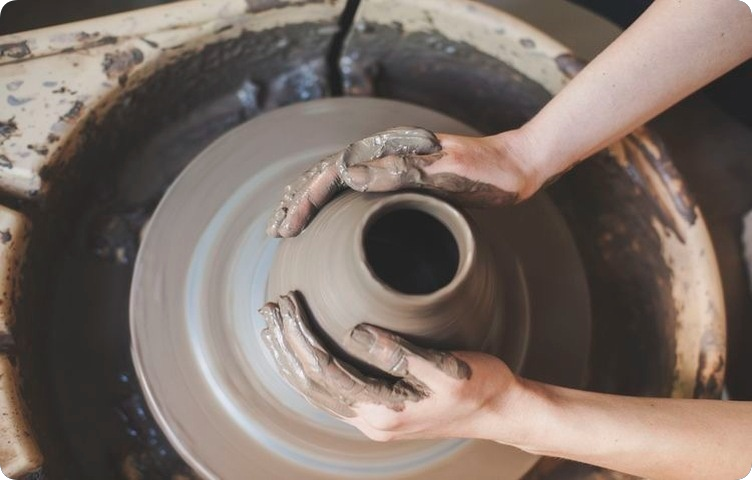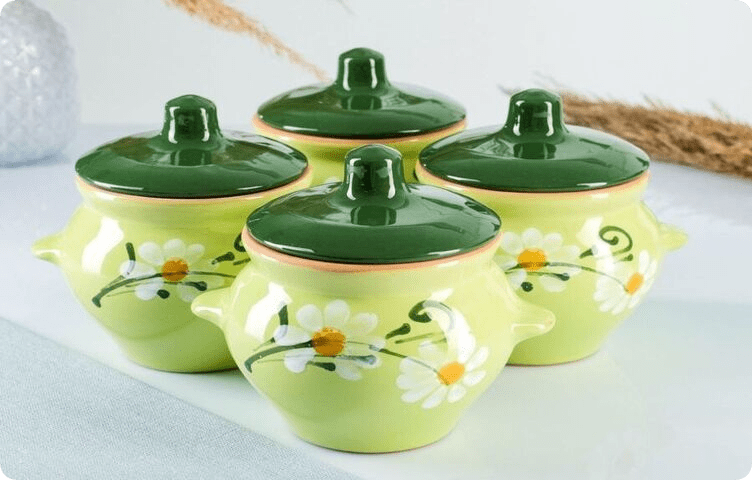Baked dishes are distinguished by their juiciness and rich aroma. Heat treatment in the oven is much healthier than frying, since it better preserves the beneficial properties of food. But under one condition - if the cook uses high-quality and safe utensils. Choosing good casserole pots is not that easy, especially if you haven't used one before. Brief tips will help you understand the features, advantages and disadvantages of this useful utensil.
History of clay baking pots
Humans began cooking over fire approximately 300,000-400,000 years ago. But there were no real dishes at that time; meat and fish were fried on hot stones. The first examples of kitchen utensils appeared in China and Japan about 30 thousand years ago. These were ceramic pots in which food was cooked over an open fire or baked in an oven. The products were not durable, and cracked or deformed from intense heat. However, the ancient Greeks and Romans already knew how to bake meat, poultry and fish in ovens, using clay or bronze vessels.
During the Middle Ages, German potters developed ceramic technology that could withstand high temperatures. The dishes were made from a mixture of clay and sand. Any medieval kitchen had earthenware and cast iron vessels for cooking in the oven.

With the advent of the wood-burning stove in the 16th century, the range of baking utensils expanded. In Europe and Russia, clay, brass, and copper products were used; in the North American colonies, iron pots were used. The development of technology in the twentieth century made it possible to create new types of metal utensils, made of stainless steel and aluminum.
Types by materials
The most popular among modern cooks are four types of baking utensils:
Clay - made on a potter's wheel, by hand. It is subjected to repeated firing, due to which it acquires high strength. Retains heat well inside and preserves the natural juiciness of products.
Ceramic - made from clay with the addition of sand and stone dust. Pots of simple shape are created using the stamping method. The surface of the products is often covered with glaze and painting. Ceramics withstands high temperatures and evenly distributes heat inside the vessel.
Porcelain - created from a mixture of clay with sand, quartz, feldspar. All ingredients are crushed as much as possible, making the finished material durable, non-porous, and resistant to temperature changes. Only special heat-resistant types of porcelain are suitable for the oven. It has non-stick properties, suitable for cooking dishes without oil, in its own juice.
Cast iron – is distinguished by its heavy weight, durability, and resistance to high temperatures. Heats up slowly and retains heat inside for a long time. The food inside the cast iron cookware does not burn and remains hot for a long time even outside the oven.
The most durable utensils are considered to be made of cast iron and heat-resistant porcelain. Clay and ceramic products are more profitable in price.
Types by volume
Baking in the oven or microwave can be done in two ways - in portions or in a common vessel. To prepare roasts and stews, it is more convenient to use products with a capacity of 700-800 ml, designed for one serving. For a guest table, the volume can be even smaller - 500-600 ml.
Portion utensils are usually produced in sets of 4-6 pieces. Since the treat is served directly in pots, such sets are equipped with beautiful glazing and painting. A large family dish, for example, pilaf, porridge, stew, can be simmered in 1-2.5 liter pots.
Pros and cons of baking pots
Cooking in the oven is one of the most useful cooking techniques. With it, the products retain most of the nutrients, and the taste and aroma are maximized. Dishes baked in pots are especially useful, since they are prepared with virtually no fat.
Let's name five more advantages of this convenient tableware:
- made from materials that are safe for health;
- has non-stick properties;
- does not require constant monitoring of the cooking process;
- combines with any type of product;
- suitable for serving.
There are much fewer disadvantages - intolerance to temperature changes and abrasive cleaning products. Ceramic and clay products canbreak when dropped.
What dishes come out best in pots?
The oven allows you to vary the methods of heat treatment - from baking to long-term simmering. Using different temperature conditions, you can cook poultry, fish, cereals and vegetables. Using crock pots imparts tenderness to even tough beef and hard beans.

Examples of delicious dishes for the oven:
- meat with mushrooms and potatoes;
- vegetable stew;
- veal in wine;
- pumpkin soup;
- chicken with rice.
A cast iron or clay pot is an ideal container for preparing any dishes with thick, aromatic sauces and fragrant seasonings. However, baking in the oven takes longer than boiling and frying on the stove.
The best brands and manufacturers
The products of the Russian brand Borisov Ceramics earned the greatest popularity in 2023. The company produces ceramic tableware, both in sets and individual products. The product is oven and microwave safe. Glazed products are distinguished by heat resistance, original shape, and beautiful painting in folk style.

How to wash and store
Allow the ceramic cookware to cool before soaking or washing it . Temperature changes may cause the pot to crack . This rule also applies to cast iron utensils. Washing in the dishwasher is only permissible for glazed ceramics. Thanks to their non-stick properties, the pots are easy to clean by hand . All you need is a non-abrasive sponge and a mild detergent. If food particles still stick to the walls, soak the cooled dishes in warm water.
Contact with hard objects can damage clay, ceramics and porcelain. To avoid this, store pots in a cupboard without stacking them on top of each other. Another storage option is in a cardboard box, placing microfiber cloths between the products.
How to choose baking pots
The main advantage of ovenware is heat resistance. Check the temperature limit indicated in the product instructions. The interval from +180 to +300° C is suitable for preparing any dishes.
Consider five more criteria:
- purpose - soups are prepared in a large container with a wide neck. For stews and baked meats you will have to buy a set of small pots;
- volume – based on 600-700 ml per consumer;
- material – if you are going to cook in the oven and microwave, choose glazed ceramics. Cast iron is only suitable for the oven;
- the presence of handles and lids - these elements simplify the cooking process;
- aesthetics - baked foods are usually served straight from the oven. Therefore, the appearance of the dishes should be attractive.
Pay attention to the texture of the surface - the more irregularities and decorative elements it has, the more difficult it is to clean. The easiest to care for is glazed utensils without decorations.
















































/https%3A%2F%2Fcomplexbar.com%2Fimages%2Fblog%2F58%2FIMG_9371-752x480.jpg)
/https%3A%2F%2Fcomplexbar.com%2Fimages%2Fblog%2F245%2Fskov_glavn.jpeg)
/https%3A%2F%2Fcomplexbar.com%2Fimages%2Fblog%2F245%2Fhaiboli.jpg)
/https%3A%2F%2Fcomplexbar.com%2Fimages%2Fblog%2F245%2Fvilki-na-stole-752x480.jpeg)
/https%3A%2F%2Fcomplexbar.com%2Fimages%2Fblog%2F246%2F2024-04-09_17.22.54.jpg)
/https%3A%2F%2Fcomplexbar.com%2Fimages%2Fblog%2F246%2F2024-04-09_17.22.47.jpg)
/https%3A%2F%2Fcomplexbar.com%2Fimages%2Fblog%2F246%2FCODE_anons_foamydrops_752%D1%85480_eng.jpg)
/https%3A%2F%2Fcomplexbar.com%2Fimages%2Fblog%2F246%2FAlina_752%D1%85480_eng.jpg)
/https%3A%2F%2Fcomplexbar.com%2Fimages%2Fblog%2F246%2F2024-04-09_17.23.22.jpg)
/https%3A%2F%2Fcomplexbar.com%2Fimages%2Fblog%2F246%2F2024-04-09_17.23.28.jpg)
/https%3A%2F%2Fcomplexbar.com%2Fimages%2Fblog%2F246%2F2024-04-09_17.23.35.jpg)
/https%3A%2F%2Fcomplexbar.com%2Fimages%2Fblog%2F246%2Fdrinksome_752%D1%85480_eng.jpg)
/https%3A%2F%2Fcomplexbar.com%2Fimages%2Fblog%2F246%2Fnude_752%D1%85480_eng.jpg)
/https%3A%2F%2Fcomplexbar.com%2Fimages%2Fblog%2F246%2F752%D1%85480_eng__1_.jpg)
/https%3A%2F%2Fcomplexbar.com%2Fimages%2Fblog%2F246%2F752%D1%85480_eng.jpg)
/https%3A%2F%2Fcomplexbar.com%2Fimages%2Fblog%2F246%2FStudioRaw_752%D1%85480_eng.jpg)
/https%3A%2F%2Fcomplexbar.com%2Fimages%2Fblog%2F246%2FDoppio_tea_752%D1%85480_eng.jpg)
/https%3A%2F%2Fcomplexbar.com%2Fimages%2Fblog%2F246%2FTognana_Stars_Stripes_752%D1%85480_eng.jpg)
/https%3A%2F%2Fcomplexbar.com%2Fimages%2Fblog%2F246%2FRona_752%D1%85480_eng.jpg)
/https%3A%2F%2Fcomplexbar.com%2Fimages%2Fblog%2F246%2FDoppio_vending_752%D1%85480_eng.jpg)
/https%3A%2F%2Fcomplexbar.com%2Fimages%2Fblog%2F246%2FEssence_sukhie_smesi_752%D1%85480_eng.jpg)
/https%3A%2F%2Fcomplexbar.com%2Fimages%2Fblog%2F246%2FODK_sukhie_smesi752%D1%85480_eng.jpg)
/https%3A%2F%2Fcomplexbar.com%2Fimages%2Fblog%2F246%2Funiforma-barmena.jpg)
/https%3A%2F%2Fcomplexbar.com%2Fimages%2Fblog%2F246%2Fkak-nanyat-barmena.jpg)
/https%3A%2F%2Fcomplexbar.com%2Fimages%2Fblog%2F246%2Fsirop_scale_2400.jpeg)
/https%3A%2F%2Fcomplexbar.com%2Fimages%2Fblog%2F246%2FPeugeot_Anons_Paris_U%27Select_Line_Daman_752%D1%85480_eng.jpg)
/https%3A%2F%2Fcomplexbar.com%2Fimages%2Fblog%2F246%2Fkofe-vostochniy.jpg)
/https%3A%2F%2Fcomplexbar.com%2Fimages%2Fblog%2F246%2FMadler.jpg)
/https%3A%2F%2Fcomplexbar.com%2Fimages%2Fblog%2F246%2Fprofbartender_glavn.jpeg)